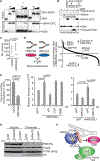HMCES Maintains Genome Integrity by Shielding Abasic Sites in Single-Strand DNA
- PMID: 30554877
- PMCID: PMC6329640
- DOI: 10.1016/j.cell.2018.10.055
HMCES Maintains Genome Integrity by Shielding Abasic Sites in Single-Strand DNA
Abstract
Abasic sites are one of the most common DNA lesions. All known abasic site repair mechanisms operate only when the damage is in double-stranded DNA. Here, we report the discovery of 5-hydroxymethylcytosine (5hmC) binding, ESC-specific (HMCES) as a sensor of abasic sites in single-stranded DNA. HMCES acts at replication forks, binds PCNA and single-stranded DNA, and generates a DNA-protein crosslink to shield abasic sites from error-prone processing. This unusual HMCES DNA-protein crosslink intermediate is resolved by proteasome-mediated degradation. Acting as a suicide enzyme, HMCES prevents translesion DNA synthesis and the action of endonucleases that would otherwise generate mutations and double-strand breaks. HMCES is evolutionarily conserved in all domains of life, and its biochemical properties are shared with its E. coli ortholog. Thus, HMCES is an ancient DNA lesion recognition protein that preserves genome integrity by promoting error-free repair of abasic sites in single-stranded DNA.
Keywords: 5-hydroxymethylcytosine; DNA repair; DNA replication; DNA-protein crosslink; HMCES; PCNA; REV1; SRAP; replication stress; translesion DNA synthesis.
Copyright © 2018 Elsevier Inc. All rights reserved.
Conflict of interest statement
Figures






References
Publication types
MeSH terms
Substances
Grants and funding
LinkOut - more resources
Full Text Sources
Other Literature Sources
Molecular Biology Databases
Research Materials
Miscellaneous

